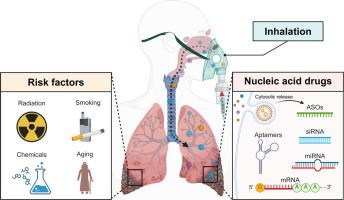Inhalable nucleic acid therapeutics for chronic pulmonary disease: Progress, challenges, and prospects
IF 9.6
1区 医学
Q1 ENGINEERING, BIOMEDICAL
引用次数: 0
Abstract
Inhalable nucleic acid drug delivery systems have garnered increasing attention as a promising strategy for the treatment of chronic pulmonary diseases, such as asthma, chronic obstructive pulmonary disease (COPD), cystic fibrosis (CF), and idiopathic pulmonary fibrosis (IPF). These diseases are often characterized by chronic inflammation, airway remodeling, and progressive lung dysfunction, posing significant clinical challenges. Nucleic acid therapeutics, including plasmid DNA, messenger RNA (mRNA), microRNA (miRNA), small interfering RNAs (siRNAs), and antisense oligonucleotides (ASOs), offer the potential to correct genetic defects, modulate aberrant gene expression, or suppress pathogenic signaling pathways. The inhalation route enables direct, non-invasive access to the lungs, offering localized delivery, rapid onset of action, and reduced systemic side effects. However, the lung presents multiple biological barriers that limit the delivery and activity of nucleic acids, including mucus clearance, enzymatic degradation, alveolar macrophage uptake, and cellular membrane penetration. To address these challenges, various delivery vectors—ranging from viral vectors to non-viral systems such as lipid nanoparticles, polymeric carriers, and hybrid nanomaterials—have been engineered to enhance stability, targeting, and transfection efficiency. This review highlights recent advances in inhalable nucleic acid delivery platforms, discusses the critical physiological and pathological barriers in the pulmonary microenvironment, and outlines current clinical progress. Finally, we explore future directions and challenges toward clinical translation of these innovative therapies.
Statement of significance
Chronic pulmonary diseases, including COPD, asthma, IPF, and CF, remain among the leading causes of morbidity and mortality worldwide, with limited treatment options that target disease pathogenesis at the molecular level. Nucleic acid therapeutics offer transformative potential to precisely regulate gene expression, correct mutations, and modulate inflammatory or fibrotic pathways. However, effective delivery to the lungs remains a critical barrier to clinical translation. This review highlights the emerging field of inhalable nucleic acid delivery systems, integrating recent advances in nanocarrier design, pulmonary targeting strategies, and the navigation of biological barriers. By bridging nucleic acid pharmacology with pulmonary drug delivery science, this review provides a comprehensive framework for the rational design and clinical development of next-generation genetic therapies for respiratory diseases. It also offers forward-looking perspectives on overcoming current translational hurdles, thereby accelerating the realization of precision gene therapy for chronic lung disorders.

可吸入核酸治疗慢性肺部疾病:进展、挑战和前景。
可吸入核酸药物递送系统作为治疗慢性肺部疾病(如哮喘、慢性阻塞性肺疾病(COPD)、囊性纤维化(CF)和特发性肺纤维化(IPF))的一种有前途的策略,已经引起了越来越多的关注。这些疾病通常以慢性炎症、气道重塑和进行性肺功能障碍为特征,提出了重大的临床挑战。核酸疗法,包括质粒DNA、信使RNA (mRNA)、微RNA (miRNA)、小干扰RNA (sirna)和反义寡核苷酸(ASOs),提供了纠正遗传缺陷、调节异常基因表达或抑制致病信号通路的潜力。吸入途径能够直接、无创地进入肺部,提供局部递送、快速起效和减少全身副作用。然而,肺部存在多种生物屏障,限制了核酸的传递和活性,包括粘液清除、酶降解、肺泡巨噬细胞摄取和细胞膜穿透。为了应对这些挑战,各种递送载体——从病毒载体到非病毒系统,如脂质纳米颗粒、聚合物载体和混合纳米材料——已经被设计出来,以提高稳定性、靶向性和转染效率。本文综述了可吸入核酸传递平台的最新进展,讨论了肺微环境中关键的生理和病理障碍,并概述了当前的临床进展。最后,我们探讨了这些创新疗法临床转化的未来方向和挑战。意义声明:慢性肺部疾病,包括COPD、哮喘、IPF和CF,仍然是世界范围内发病率和死亡率的主要原因之一,在分子水平上靶向疾病发病机制的治疗选择有限。核酸疗法提供了精确调节基因表达、纠正突变和调节炎症或纤维化途径的转化潜力。然而,肺的有效输送仍然是临床转化的关键障碍。本文综述了可吸入核酸递送系统这一新兴领域,整合了纳米载体设计、肺靶向策略和生物屏障导航方面的最新进展。本文通过将核酸药理学与肺部药物传递科学相结合,为新一代呼吸系统疾病基因疗法的合理设计和临床开发提供了一个全面的框架。它还为克服目前的翻译障碍提供了前瞻性的观点,从而加速实现慢性肺部疾病的精确基因治疗。
本文章由计算机程序翻译,如有差异,请以英文原文为准。
求助全文
约1分钟内获得全文
求助全文
来源期刊

Acta Biomaterialia
工程技术-材料科学:生物材料
CiteScore
16.80
自引率
3.10%
发文量
776
审稿时长
30 days
期刊介绍:
Acta Biomaterialia is a monthly peer-reviewed scientific journal published by Elsevier. The journal was established in January 2005. The editor-in-chief is W.R. Wagner (University of Pittsburgh). The journal covers research in biomaterials science, including the interrelationship of biomaterial structure and function from macroscale to nanoscale. Topical coverage includes biomedical and biocompatible materials.
 求助内容:
求助内容: 应助结果提醒方式:
应助结果提醒方式:


